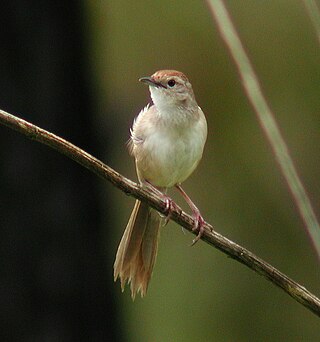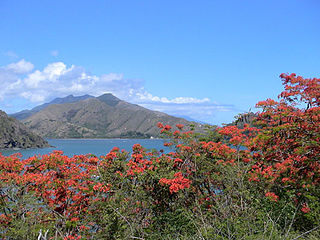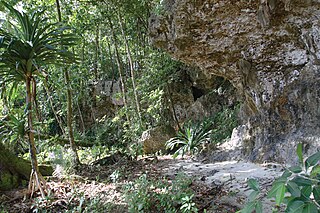Old World warblers are a large group of birds formerly grouped together in the bird family Sylviidae. They are not closely related to the New World warblers. The family held over 400 species in over 70 genera, and were the source of much taxonomic confusion. Two families were split out initially, the cisticolas into Cisticolidae and the kinglets into Regulidae. In the past ten years they have been the subject of much research and many species are now placed into other families, including the Acrocephalidae, Cettiidae, Phylloscopidae, and Megaluridae. In addition some species have been moved into existing families or have not yet had their placement fully resolved. A smaller number of warblers, together with some babblers formerly placed in the family Timaliidae and the parrotbills, are retained in a much smaller family Sylviidae.
The long-legged thicketbird is a small bird endemic to Fiji. The species is sometimes known as the long-legged warbler. It was formerly classified as the sole representative of the genus Trichocichla.

The brown songlark, also Australian songlark, is a small passerine bird found throughout much of Australia. A member of the family Locustellidae, this species is notable for sexual size dimorphism, among the most pronounced in any bird. It is a moderate-sized bird of nondescript plumage; the female brownish above and paler below, the larger male a darker brown.

The songlarks are a pair of species of birds in the family Locustellidae. Most taxonomists place them together with the thicketbirds in the genus Cincloramphus. They are alternatively placed in the genus Megalurus.

Cincloramphus is a genus of birds in the grassbird family Locustellidae.
The buff-banded thicketbird or buff-banded bushbird is a species of Old World warbler in the family Locustellidae. It is found in Indonesia (Timor) and East Timor.

The rufous songlark is a species in the family Locustellidae endemic to Australia.
The New Britain thicketbird or Bismarck thicketbird is a bird species. It used to be placed in the "Old World warbler" family Sylviidae, but it does not seem to be a close relative of the typical warblers; probably it belongs in the grass warbler family Locustellidae. It is found only in the rarely visited highlands of the island of New Britain in Papua New Guinea.
The Bougainville thicketbird is a bird species. It had been placed in the "Old World warbler" family Sylviidae, but it does not seem to be a close relative of the typical warblers; probably it belongs in the grass warbler family Locustellidae. It is endemic to Bougainville Island. Its natural habitat is subtropical or tropical dry lowland grassland. It used to be considered conspecific with the Santo thicketbird and the New Britain thicketbird.

The New Caledonia thicketbird or New Caledonia grassbird, is a bird species. Previously placed in the "Old World warbler" family Sylviidae, it does not seem to be a close relative of the typical warblers; probably it belongs in the grass warbler family Locustellidae. This species is endemic to New Caledonia.

The rusty thicketbird is a bird species. Previously placed in the "Old World warbler" family Sylviidae, it does not seem to be a close relative of the typical warblers; probably it belongs in the grass warbler family Locustellidae. It is found in New Britain only.

The striated grassbird is an "Old World warbler" species in the family Locustellidae. It was formerly placed in the family Sylviidae. It is now the only species placed in the genus Megalurus.

The tawny grassbird is a large songbird that is part of the grass- and bush-warbler family (Locustellidae) commonly found in grassland and reedbed habitats. It is streaked above and has a distinctive rich brown cap. Its underside is paler and it has a long graduated tail. They call often with "loud, grumpy churring calls and a longer call that starts tick-tick-tick-tick and ends with an explosive descending trill".

Locustellidae is a newly recognized family of small insectivorous songbirds ("warblers"), formerly placed in the Old World warbler "wastebin" family. It contains the grass warblers, grassbirds, and the Bradypterus "bush warblers". These birds occur mainly in Eurasia, Africa, and the Australian region. The family name is sometimes given as Megaluridae, but Locustellidae has priority.

Mont Panié is a mountain on the island of Grande Terre in New Caledonia, a special collectivity of France located in the south-west Pacific Ocean. At 1,628 metres (5,341 ft), it is the island's highest point. Mont Panié is situated in the Chaîne Centrale mountain range. The second highest peak on the island, Mount Humboldt, is nearly as tall as Mont Panié, with an elevation of 1,618 metres (5,308 ft).

The Papuan grassbird is a species of typical grassbird in the family Locustellidae. The species was once treated as several subspecies of the tawny grassbird, but the two do not interbreed where their ranges are sympatric. The species is endemic to New Guinea and its satellite islands. There are seven subspecies ranging across montane areas of New Guinea, New Britain and New Ireland. It is a fairly large typical grassbird, 20–23 cm (7.9–9.1 in) long and weighing 40 g (1.4 oz).
The Guadalcanal thicketbird is a bird species. It used to be placed in the "Old World warbler" family Sylviidae, but it does not seem to be a close relative of the typical warblers; it belongs in the grass warbler family, Locustellidae. It is found on the island of Guadalcanal in the Solomon Islands.

The New Britain-New Ireland lowland rain forests is a tropical moist forest ecoregion in Papua New Guinea. The ecoregion covers the lowland rain forests of New Britain, New Ireland, and nearby islands in the Bismarck Archipelago.

The Northern Plains Grassland (NPGL) is an open, shrubby temperate grassland community located in northern Victoria straddling the Murray Darling Depression and Wimmera, extending to the Riverina and South Western Slopes regions in southern New South Wales. Floristically rich, the area features 30 native plant species per 100 m2.












